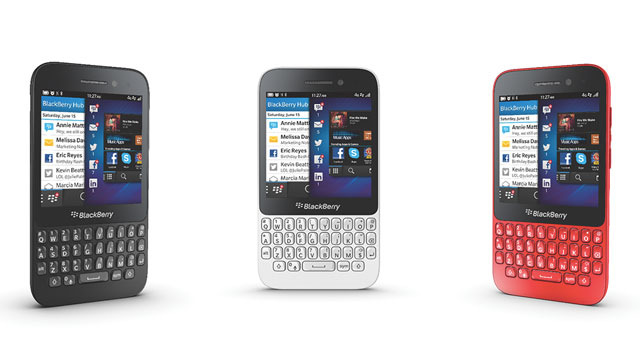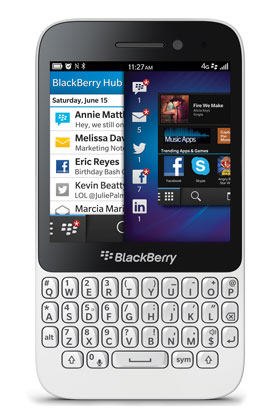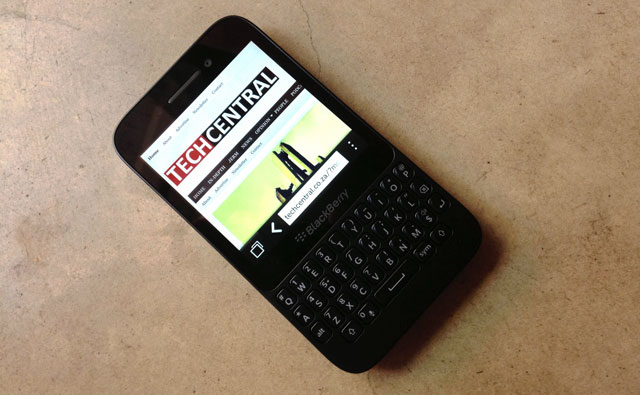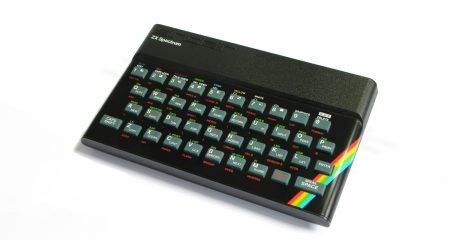
Having spent the past six months trumpeting its top-end BlackBerry 10 (BB10) devices, the company formerly known as Research in Motion has finally released a cheaper handset running the new software.
The Q5 is positioned as the successor to the popular Curve range. The problem is, it lacks most of the attributes that make the Curve so appealing and faces the same challenges as the more expensive Z10 and Q10 phones.
It’s been years since BlackBerry has been a serious contender at the top end of the smartphone market. During that time, however, it’s remained one of the most popular device manufacturers at the low end of the market thanks to its entry-level products offering great value when combined with BlackBerry’s flat-rate data plans.
This fixed-cost approach to data has kept Curve sales ticking over tidily. But BlackBerry has ambitions greater than competing with Nokia and a slew of Chinese Android device manufacturers for the bottom end of the market. It wants to play in the big leagues. It made this clear when it launched the Z10 and then the Q10, which, like the Q5, do not come with flat-rated data packages.
 BlackBerry’s first two BB10 devices allowed it to hedge its bets. The all-touch Z10 could compete with Apple’s iPhone and Samsung’s flagships — in terms of specifications at least — while the Q10, with its physical Qwerty keyboard and familiar styling, was intended to satisfy Bold users.
BlackBerry’s first two BB10 devices allowed it to hedge its bets. The all-touch Z10 could compete with Apple’s iPhone and Samsung’s flagships — in terms of specifications at least — while the Q10, with its physical Qwerty keyboard and familiar styling, was intended to satisfy Bold users.
The Q5 is a different, more peculiar creature. Its plastic keys, buttons and housing make it clear it’s not a premium device, but with a recommended retail price before operator subsidies of R4 999, it’s not exactly budget, either.
It’s easy to tell which corners were cut to keep the Q5’s production costs down. Heavy use of plastic aside, the design is plain and uninspiring and, at 10,8mm, it’s fairly thick. The 3,1-inch, 720×720 pixel display is LCD (rather than the Amoled display found on the Q10), the processor is a 1,2GHz dual-core specimen, the primary camera offers five megapixels and the internal storage is limited to 8GB.
Despite this, the screen is crisp and vibrant, touch input is responsive, opening and closing applications is speedy — as is moving between them — and the rear camera delivers passable results. The Q5 isn’t going to handle the most graphics-intensive games, nor is its camera going to produce poster-printable images, but then it’s not a top-end device.
The real problem with the Q5 is that it’s dull as dishwater. From its design to its feature set, nothing about the handset screams desirability. Also, it looks cheaper than it is when really that ought to be the other way around.
Being a BB10-powered handset, the Q5 suffers from the same failings as the Z10 and Q10 — most notably a lack of applications. BlackBerry has worked hard to downplay this problem, subsidising developers to update their BB7 apps for BB10 and trying to convince makers of the most popular applications to get on board, too.
But there’s still no Instagram (a real pity, given the Q5’s square display); no Viber; no Snapseed; no apps for Google’s various services; no Simfy, Soundcloud or Shazam; no Flipboard or Readability; no Nike+ Running, Runkeeper or Strava. There are substitutes for many of these, but — ask an Instagram user — you can’t beat the real thing.
Moreover, all of the problems of BB10 that have vexed us to date remain.
The camera interface is counterintuitive, for example. The fact that you have to hold the camera icon on the lock screen for three seconds is just silly.
And the unified inbox, BlackBerry Hub, may suit those who don’t see much activity in their feeds, but we find it overwhelming and annoying.
Also, the Hub doesn’t play well with others. Read a tweet or a Facebook notification in a separate app, or on a separate device, and the Hub’s notification remains.
Then there’s the problem of the Q5’s keyboard. BlackBerry will argue that there are still those who prefer a physical keyboard — fair enough — but the Q5’s keyboard isn’t especially good. The keys aren’t as tapered as those on the Q10, making them more flush with the device’s surface and not as easy to distinguish. Also, having the keys evenly spaced, with small spaces between them and in neat rows, does nothing to improve the typing experience. Gone is the ergonomic feel of the keys found on the likes of the BlackBerry Bold in favour of flatness and uniformity. The result is a keyboard that’s too broad, making the keys on the edges awkward to reach with one hand.

Even worse is the fact that the exceptional work BlackBerry has done with predictive text, and text input generally, on it’s touchscreen Z10 is lost on the Q5, as it is on the Q10. BlackBerry used to be known as the brand for mobile typists. The Q5’s physical keyboard does nothing to sustain that reputation. If anything, it’s an excellent argument as to why the prevalence of physical keyboards will continue to dwindle as touch displays become cheaper.
The Q5 is positioned as a mid-level device to replace the Curve and to attract those for whom thousands of rand more for a Z10 or Q10 is simply too much. The problem is, at R4 999, the Q5 is still twice the price of an entry-level Curve or any number of Nokia S40 or Android devices.
For roughly the same price as a Q5, you could buy the Nokia Lumia 920, HTC One X, Motorola Razr HD or Google Nexus 4 — all top-end devices, all offering better cameras and other hardware.
Unlike the Q10 and Z10, the Q5 doesn’t offer a removable battery — another mark against it given this was one of the features that kept the company’s business-orientated credentials in place and separated BlackBerry’s devices from the competition. However, with a 2 180mAh battery, the Q5 will make it through even the longest of workdays.
In closing, the BlackBerry Q5 isn’t a bad device. It’s just a bit dull and too expensive. In a market segment as crowded as the midrange one, there’s no reason to recommend the Q5. — (c) 2013 NewsCentral Media




